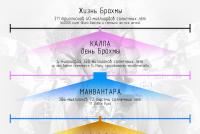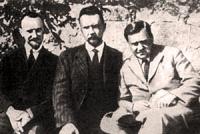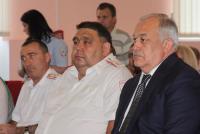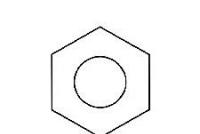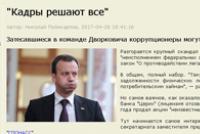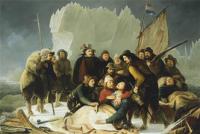Records in science and technology. Elementi. Finding the most important words
Nature has 94 chemical elements. For the whole hour, 15 transuranium elements are taken away piece by piece (elements from 95th to 109th), the base of 10th without any number.
The widest
Lithosphere. Kisen (O), 46.60% per vaga. Vіdkritiy 1771 r. Karl Scheele (Sweden).
atmosphere. Nitrogen (N), 78.09% for the bulk, 75.52% for the car. Vіdkritiy 1772 r. Rutherford (Great Britain).
Vsesvit. Voden (N), 90% of speech. Decree in 1776 Henry Cavendish (Great Britain).
Nairіdkіnіshy (z 94)
Lithosphere. Astatine (At): 0.16 g in earth's crust. Vіdkritiy 1940 Corson (USA) with spivrobitnikami. The isotope astatine 215 (215 Аt) is sustenance in nature (reviewed in 1943 by B. Karlik and T. Bernert, Austria) is less than 4.5 nanograms.
atmosphere. Radon (Rn): total 2.4 kg (6 10 -20 about one part per 1 million). Vіdkritiy 1900 r. Dorn (Nimechchina). The concentration of this radioactive gas in the areas of deposits of granite rocks has caused a low incidence of cancer. The mass of radon, which in the earth's crust, increases atmospheric gas reserves, is 160 tons.
lightest
Gas. Water (H) density 0.00008989 g / cm 3 at a temperature of 0 ° C vice in 1 atm. Vіdkritiy 1776 r. Cavendish (Great Britain).
metal Lithium (Li), which has a thickness of 0.5334 g / cm 3 is the lightest of all hard speeches. Vіdkritiy 1817 Arfvedson (Sweden).
Maximum width
Osmіy (Os), which has a thickness of 22.59 g / cm 3 is the most important of all hard speeches. Vіdkritiy 1804 r. Tennant (UK).
Naivazhchiy gas
Him є radon (Rn), thickness of which is 0.01005 g / cm 3 at 0 ° C. Vіdkritiy 1900 r. Dorn (Nimechchina).
The rest of the otrimanih
Element 108, or uniloktіy (Uno). The previous name was given by the International Union of Theoretical and Applied Chemistry (IUPAC). Withdrawal from the quarter 1984 Münzenberg and his collaborators (Zahidna Nіmechchina), yak poserіgali total 3 atoms of the element in the laboratory of the Partnership for the accomplishment of important ions in Darmstadt. At the black fate, there was a reminder that the element was also taken away by Yu.Ts. Oganesyan and colleagues at the Joint Institute for Nuclear Research, Dubna, SRSR.
A single annihilation atom (Une) was eliminated as a result of bombardment with airborne ions in the laboratory of the Partnership for the Research of Important Ions, Darmstadt, Zahidna Nimechchina, 29 April 1982. The new one has the largest serial number (element 109) and the largest atomic number. Behind the earlier tributes, the radyansk vcheni posterigali the adoption of the isotope of element 110 with the atomic mass 272 (the front name is ununily (Uun)).
The purest
Helium-4 (4 He), withdrawal from the quarter 1978 P.V. McLintock from Lancaster University, USA, may be less than 2 parts of a house for 10 15 parts of a room.
The firmest
Vuglets (C). In the allotropic form, the hardness of diamond is 8400 by the Knoop method.
Naydorochchiy
Californian (Cf) was sold in 1970. for the price of 10 dollars. per microgram. Vіdkritiy 1950 Seaborg (USA) with spivrobitnikami.
Most plastic
Gold (Au). From 1 g you can climb a drіt zavdovka 2.4 km. Seen from 3000 BC
Nayvischa between spirituality for development
Bir (B) - 5.7 DPa. Vіdkritiy at 1808 r. Gay-Lussac and Tenard (France) and X. Maiden (Great Britain).
Melting point/boiling point
Nainizhcha. The middle non-metal helium-4 (4He) has the lowest melting point of –272.375°C at a pressure of 24.985 atm and the lowest boiling point of –268.928°C. Helium water in 1868 Lock'er (Great Britain) and Jansen (France). Monoatomic water (H) can be non-releasing above the surface gas. The middle metals have the same parameters as mercury (Hg): -38.836 ° С (melting point) and 356.661 ° С (boiling point).
Naivishcha. The middle non-metal has a melting point and a boiling point at the known prehistoric hour of coal (C): 530°С and 3870°С. We argue that graphite is stable at high temperatures. Passing at 3720°С solid into a steam-like mill, graphite can be truncated as a solid under a pressure of 100 atm and a temperature of 4730°С. The middle metals have the same parameters as tungsten (W): 3420 ° С (melting point) and 5860 ° С (boiling point). Vіdkritiy 1783 r. H.H. and F. d "Eluyarami (Spain).
Isotopes
The largest number of isotopes (36 each for skin) is for xenon (Xe), declared in 1898. Ramsay and Travers (Great Britain), and cesium (Cs), declared in 1860. Bunsen and Kirchhoff (Nimechchina). The smallest quantity (3: protium, deuterium and tritium) in the water (N), declared 1776 r. Cavendish (UK).
The most stable. Tellurium-128 (128 Ti), due to subvariant beta-decay, may have a relapse period of 1.5 10 24 years. Tellurium (Ti) was mentioned in 1782. Müller von Reichenstein (Austria). The isotope 128 Ti was first detected in a natural setting in 1924. F. Aston (Great Britain). Data about yoga stability were reaffirmed in 1968 by E. Alexander Jr., B. Shrinivasan and O. Manuel (USA). The record for alpha decay to lie with samaria-148 (148 Sm) is 8 10 15 years. The record for beta decay belongs to the cadmium isotope 113 (113 Cd) - 9 10 15 years. Obidva isotopes were discovered in the natural camp by F. Aston, obviously, in 1933 and 1924. The radioactivity of 148 Sm was determined by T. Wilkins and A. Dempster (USA) in 1938, and the radioactivity of 113 Cd in 1961. by D. Watt and R. Glover (Great Britain).
The most stable. The hour of life of lithium-5 (5 Li) is surrounded by 4.4 10 -22 s. The isotope was first identified by E. Titterton (Australia) and T. Brinkley (Great Britain) in 1950.
Home row
The difference between the melting point and the boiling point, the element with the shortest natural series is the inert gas neon (Ne) - only 2.542 degrees (from -248.594 ° С to -246.052 ° С), which also has the most negative degree of the radioactive series (345) transuranic element neptunium (Np) (at 637°С to 4090°С). However, if you take the right row of rіdin to respect - from the melting point to the critical point, then the shortest period of the element helium (He) is only 5.195 degrees (from absolute zero to -268.928 ° C), and the last one - 10200 degrees - for tungsten (vіd 3420°C to 13620°C).
New Year's Eve
Among non-radioactive speeches, the most efficient exchanges were established for beryllium (Be) - the maximum permissible concentration (HDC) of this element is more than 2 μg / m 3. Among the radioactive isotopes, which are found in nature or are generated by nuclear installations, the most efficient interchanges were installed for thorium-228 (228 Th), which was earlier than the manifestations of Otto Gan (Nimechchina) in 1905 (2.4 10 -16) g / m 3), and instead of water - for radium-228 (228 Ra), discovered by O. Hahn in 1907. (1.1 10 -13 g/l). From a glance of ecology, the stench may be significant periods of a sudden collapse (it will take about 6 months).
Guinness Book of Records, 1998
We present a selection of chemical records from the Guinness Book of Records.
At the link with tim, that new speeches are constantly being voiced, but the order is not fast.
Chemical records for inorganic speeches
- The widest element in the earth's bark is kisen O. Yogo vmist becomes 49% of the mass of earth measles.
- The most important element in the earth's crust is astatine At. Yogo instead of all earthly crust to become less than 0.16 gr. France borrows another place for money Fr.
- The widest element in the universe is water N. Approximately 90% of all atoms in the universe are water. Another place for the breadth of the world is borrowing helium He.
- The strongest stable oxide is a complex of krypton difluoride and surmi pentafluoride. Through a strong oxidizing effect (oxidizing all the elements at a different stage of oxidation, including oxidizing oxygen again), it is important to reduce the electric potential for a new one. The only retailer, which reacts to him, dosit properly - anhydrous fluoride water.
- The largest speech on planet Earth is osmium. The density of osmium is 22.587 g/cm3.
- The lightest metal is lithium Li. The content of lithium is 0.543 g/cm3.
- The most widely used material is ditungsten carbide W 2 C. The density of ditungsten carbide is 17.3 g/cm 3 .
- At this hour, a hard speech with the least dense є graphene aerogels. The stench is a system of graphene and nanotubes filled with rubbed balls. The lightest of these aerogels has a thickness of 0.00016 g/cm 3 . Anteriorly, there is a hard speech with the smallest gap - silicon aerogel (0.005 g / cm3). Silicon aerogel vicorous is used for the selection of micrometeorites present at the tails of comets.
- The lightest gas i, the water hour, the lightest non-metal - the whole day. Weight of 1 liter of water is more than 0.08988 gr. Before that, the water is also a low-melting non-metal with a great pressure (the melting point is up to -259.19 0 С).
- Nailegsha native land is a rare water. Weight of 1 liter of rare water becomes less than 70 grams.
- The most important inorganic gas at room temperature is tungsten hexafluoride WF 6 (boiling temperature is +17 0 C). The content of tungsten hexafluoride as gas becomes 12.9 g/l. Among gases with a boiling point lower than 0 °C, the record is for TeF 6 telurium hexafluoride from open gas at 25 0 С 9.9 g / l.
- The world's most expensive metal is Californian Cf. The price of 1 gram of the isotope 252 Cf is 500 thousand. US dollars.
- Helium He є rechovina іz the lowest boiling temperature. The boiling temperature is as high as -269 0 С. Navіt at absolute zero vіn is filled with rare and may be subtracted from a hard one that looks less like a vice (3 MPa).
- The largest refractory metal with the highest boiling point is tungsten W. The melting point of tungsten is +3420 0С, and the boiling temperature is +5680 0С.
- The most refractory material - carbide alloy hafnium and tantalum (1:1) (melting point +4215 0 С)
- The lightest metal is mercury. The melting point of mercury is hot -38.87 0 C. Mercury is also the most important motherland, the thickness at 25 ° C becomes 13.536 g / cm 3.
- Nastіykishim to acids metal є іridіy. Until this hour, it is impossible to find acidity and chi yogo sumishi, in some of them there is a lot of iridium. However, yoga can be found in meadows with oxidizing agents.
- The strongest stable acid is the origin of antimony pentafluoride in water fluoride.
- The hardest metal is chromium Cr.
- The most soft metal at 25 0 C is cesium.
- The hardest material, like before, is diamond, although there are already close to a dozen speeches, which are close to new for hardness (carbide and boron nitride, titanium nitride, then).
- The most electrically conductive metal for room temperature is Ag.
- The lowest speed for the sound of rare helium at a temperature of 2.18 K, it becomes only 3.4 m / s.
- The best sound quality in diamond is 18600 m/s.
- An isotope with the shortest decay period for Li-5, which decays in 4.4 10-22 seconds (proton wick). After such a small hour of life, not all vcheni know the fact of this reason.
- An isotope with a late decay period found to be Te-128, and a later decay period of 2.2 1024 years (sustained β-decay).
- The largest number of stable isotopes is xenon and cesium (36 each).
- The shortest names of a chemical element are boron and iodine (3 letters each).
- The found names of the chemical element (eleven letters each) are protactin Pa, rutherford Rf, Darmstadt Ds.
Chemical records for organic speeches
- The most important organic gas at room temperature and the most important gas at room temperature is N-(octafluorobut-1-ilene)-O-trifluoromethylhydroxylamine (bp. +16 C). Yogo thickening in the presence of gas becomes 12.9 g / l. Among gases with a boiling point lower than 0°C, the record for perfluorobutane from open gas at 0°C is 10.6 g/l.
- Naigirshoy rechovina є denatoniya saccharinate. The combination of denatonium benzoate with sodium saccharin gave speech 5 times higher, the lower record holder (denatonia benzoate).
- The most non-toxic organic rechovina is methane. With an increase in concentration, intoxication is caused through a lack of sourness, and not afterward.
- The strongest adsorbent for water withdrawals in 1974 is the use of similar starch, acrylamide and acrylic acid. Tsya speech is built to tame water, as if 1300 times I have moved the water.
- The strongest adsorbent for petroleum products is carbonaceous aerogel. 3.5 kg of natural speech and 1 ton of oil.
- The most stinking pollutants are ethylselenol and butylmercaptan - their smell is a nasty combination of smells of rotting cabbage, chasnik, tsibula and sewage at once.
- N-((2,3-methylenedioxyphenylmethylamino)-(4-cyanophenylimino)methyl)aminooctova acid (lugduname). Tsya rechovina in 205 000 times overwhelmed by malt 2% of sucrose varieties. Use a sprat of yoga analogues from a similar malt. From industrial speeches, the most malted is talin (a complex of thaumatin and aluminum salts), which is malted for sucrose in 3,500-6,000 times. In the rest of the hour neotam appeared at the food industry, who made malt 7000 times more for sucrose.
- The most important enzyme is nitrogenase, which catalyzes the assimilation of atmospheric nitrogen by bulbar bacteria. The new cycle of converting one molecule to nitrogen into 2 ions of ammonium takes two seconds.
- Organic speech with the largest amount of nitrogen - either bis (diazotetrazolyl) hydrazine C2H2N12, which will avenge 86.6% nitrogen, or tetraazidomethane C (N3) 4, which will avenge 93.3% nitrogen ) . Tse vibukhovi speech, super-sensitive to the blow, rubbing that heat. From inorganic speeches, the record is extremely close to gas-like nitrogen, that is, from the bottom - nitrous acid HN 3.
- The found chemical name is available 1578 characters in English writing and modified nucleotide sequence. This speech is called: Adenosene. N--2'-O-(tetrahydromethoxypyranyl)adenylyl-(3'→5')-4-deamino-4-(2,4-dimethylphenoxy)-2'-O-(tetrahydromethoxypyranyl)cytidylyl-(3'→5 ')-4-deamino-4-(2,4-dimethylphenoxy)-2'-O-(tetrahydromethoxypyranyl)cytidylyl-(3'→5')-N--2'-O-(tetrahydromethoxypyranyl)cytidylyl-(3 '→5')-N--2'-O-(tetrahydromethoxypyranyl)cytidylyl-(3'→5')-N--2'-O-(tetrahydromethoxypyranyl)guanylyl-(3'→5')-N- -2′-O-(tetrahydromethoxypyranyl)guanylyl-(3'→5′)-N--2′-O-(tetrahydromethoxypyranyl)adenylyl-(3′→5′)-N--2′-O-(tetrahydromethoxypyranyl )cytidylyl-(3'→5′)-4-deamino-4-(2,4-dimethylphenoxy)-2′-O-(tetrahydromethoxypyranyl)cytidylyl-(3′→5′)-4-deamino-4-( 2,4-dimethylphenoxy)-2'-O-(tetrahydromethoxypyranyl)cytidylyl-(3'→5')-N--2'-O-(tetrahydromethoxypyranyl)guanylyl-(3'→5')-4-deamino- 4-(2,4-dimethylphenoxy)-2'-O-(tetrahydromethoxypyranyl)cytidylyl-(3'→5')-N--2'-O-(tetrahydromethoxypyranyl)cytidylyl-(3'→5')-N --2'-O-(tetrahydromethoxypyranyl)cytidylyl-(3'→5')-N--2'-O-(tetrahydromethoxypyranyl)adenylyl-(3'→5')-N--2' -O-(tetrahydromethoxypyranyl)cytidylyl-(3'→5′)-N--2′-O-(tetrahydromethoxypyranyl)cytidylyl-(3′→5′)-N--2′,3′-O-( methoxymethylene)-octadecakis(2-chlorophenyl)ester. 5'-.
- DNA, which has found its chemical name, is seen in human mitochondria and consists of 16569 base pairs. Povna naming tsієї with the help of revenge is close to 207,000 characters.
- The system with the largest number of rіdins, which do not change, will be re-adjusted to the components after mixing 5 rіdin: mineral oil, silicone oil, water, benzyl alcohol and N-perfluoroethylperfluoropyridine.
- The best organic homeland at room temperature is ce diodomethane. Yogo thicken to become 3.3 g / cm3.
- Highly refractory individual organic speeches and aromatic slabs. Condensing cetetrabenzheptacene (melting point +570 C), non-condensing - p-septifenil (melting point +545 C). It is clear that the melting point is not exactly known for some of them, for example, for hexabenzocoronene, it is shown that the melting point is higher than 700 C. The temperature-sealing product polyacrylonitrile is decomposed at a temperature of close to 1000 C.
- Organic speech, which has the highest boiling point, is ce hexatriaconylcyclohexane. Boil wine at +551°С.
- The found alkane is nonacontatrictane C390H782. Yogo was specially synthesized for further crystallization of polyethylene.
- The found protein is the protein of m'azovoy tissue titin. Dovzhina yogo lie down in view of the living organism and localization. Titin mice, for example, may have 35213 amino acid deposits (mol. vaga 3906488 Da), human titin may have up to 33423 amino acid deposits (mol. vaga 3713712 Da).
- The found genome is the genome of the roslin paris japonica (Paris japonica). Vіn revenge 150 000 000 000 base pairs - 50 times more, lower in humans (3200000000 base pairs).
- The largest molecule is the DNA of the first human chromosome. Won revenge close to 10000000000 atoms.
- Individual vibukhovy speech with the most swirling detonation є 4,4′-dinitroazofuroxan. Yogo vimiryan swidk_detonation became 9700 m/s. Behind the unfathomable evidence, ethyl perchlorate can be added to the greater degree of detonation.
- Individual vibukhovy speech with the greatest warmth of vibukha є ethylene glycol dinitrate. Yogo heat vibuhu 6606 kJ/kg.
- The strongest organic acid is pentacyanocyclopentadiene.
- The strongest support can be є 2-methylcyclopropenyllithium. The strongest non-ionogenic base is phosphazene, it is easy to finish the harvest.
A chemical element is a general term that describes the agglomeration of atoms in simple speech, so that it cannot be divided into simple (behind the structure of their molecules) warehouses. Show yourself that you will take a piece of clean air from the sack and add yoga to hypothetical warehouses for help, whether I will add to the method, if it is found by chemists. However, you can’t do anything, you can’t split up even easier. Simple speech - zalizu - vydpovidaє chemical element Fe.
Theoretically appointed
Significance of more experimental fact can be explained with the help of such a designation: a chemical element is an abstract collection of atoms (not molecules!) of a similar simple speech, i.e. atoms in one and the same form. Yakby, having discovered a way to marvel at the skin with ten atoms, at the shmatka of a clean saliva, a hidden one, all the stinks would be the same - the atoms of the salve. On the opposite side of this, the chemical side, for example, the oxide of the salt, zavzhd avenge at least two different types of atoms: the atoms of the salt and the atoms of the acid.
Terms, yakі next to know
atomic mass: the mass of protons, neutrons and electrons that make up the atom of a chemical element.
atomic number: the number of protons in the nucleus of an atom of an element
Chemical symbol: letter or a pair of Latin letters, which are the designation of this element.
Spoluka is chemical: speech, which is composed of two or more chemical elements, combined one with one in a singing proportion
Metal: an element that absorbs electrons in chemical reactions with other elements
Metaloid: an element that reacts differently as a metal, and sometimes as a non-metal.
Nemetal: an element that does not take electrons from chemical reactions with other elements
Periodic system of chemical elements: system of classification of chemical elements up to their atomic numbers.
synthetic element: one that is taken off piece by piece in the laboratory, and, as a rule, does not grow in nature

Natural and synthetic elements
Ninety-two chemical elements thrive in the nature of the Earth. Others were taken piece by piece in laboratories. A synthetic chemical element is not, as a rule, a product of nuclear reactions in attached particles (attachments that vicorate to increase the speed of subatomic particles, such as electrons and protons) or nuclear reactors (attachments that are vicorated for energy management, which are reactive) . The first to take away the synthetic element with atomic number 43 became technetium, which was discovered in 1937 by Italian physicists C. Perr'e and E. Segre. Cream of technetia and promethium, all synthetic elements make nuclei larger, lower than those of uranium. The rest of the synthetic chemical element, which, having omitted its name, is whole livermorium (116), and in front of it is Flerovium (114).

Two dozen wide and important elements
| name | Symbol | Hundreds of total atoms * | Dominance of chemical elements (for the greatest room minds) |
|||
| At the All-world | At the earth's crust | By the sea water | In the human body |
|||
| Aluminum | Al | - | 6,3 | - | - | Lightweight, shiny metal |
| calcium | Ca | - | 2,1 | - | 0,02 | Enter to the warehouse of natural minerals, turtles, brushes |
| Vuglets | W | - | - | - | 10,7 | Basis of all living organisms |
| Chlorine | Cl | - | - | 0,3 | - | bran gas |
| Mid | Cu | - | - | - | - | Only pure metal |
| Gold | Au | - | - | - | - | Only yellow metal |
| Helium | He | 7,1 | - | - | - | Duze light gas |
| Voden | H | 92,8 | 2,9 | 66,2 | 60,6 | The lightest of all elements; gas |
| Iodine | I | - | - | - | - | Nemetal; vikoristovuetsya like an antiseptic zasib |
| Zalizo | Fe | - | 2,1 | - | - | Magnetic metal; vikoristovuetsya for virobnitsa chavun and steel |
| Lead | Pb | - | - | - | - | Soft, important metal |
| Magnesium | mg | - | 2,0 | - | - | Duje light metal |
| Mercury | hg | - | - | - | - | rare metal; one of two rare elements |
| Nikel | Ni | - | - | - | - | Resistant anti-corrosion metal; vikoristovuyut coins |
| Nitrogen | N | - | - | - | 2,4 | Gas, the main component of air |
| Kisen | Pro | - | 60,1 | 33,1 | 25,7 | Gas, other important povitrya component |
| Phosphorus | R | - | - | - | 0,1 | Nemetal; respectful to roslyn |
| potassium | Before | - | 1.1 | - | - | Metal; respectful to Roslyn; ring out call "potash" |
* If the value is not specified, the element becomes less than 0.1 cm.
Great vibukh as the reason for the adoption of matter
What chemical element was the most important in the All-World? Vcheni vvazhayut, scho at a vіdpovіd tse pitannya to lie at the stars and at the processes, with the help of which the stars are formed. Vsesvit, as vvazhayut, vinik at this moment at the hour of 12 to 15 billion years ago. Until this moment, nothing existent, crim energy, do not think. Alas, it happened that turned this energy into a majestic vibukh (the so-called Great vibukh). At the next second after the Great vibe, matter began to form.
The first simplest forms of matter that appeared were protons and electrons. The deyakі їх unite in atom water. The rest is made up of one proton and one electron; the simplest atom, which can be.

Quite frankly, by stretching 3rd periods for an hour, the atoms began to climb at once from the singing areas of the expanse, satisfying the deep gloom. The water from these glooms was drawn from the compact gravitational forces. They began to finish the water with scallops for a healthy qi gloomy water, in order to shape the stars.
Zirki yak chemical reactors of new elements
Zirka is just a mass of speech, as it generates the energy of nuclear reactions. The most extensive of these reactions is the combination of four atoms in water to form one helium atom. Just as little stars began to form, then helium became another element that appeared at the All-world.
If the stars become older, the stench will pass from water-helium nuclear reactions to other types. The stench of the atom of helium satisfies the atom of coal. Pіznіshe аtomy uglezyu utvoryuyut kisen, neon, sodium and magnesium. More pіznіshe neon and kisen will unite one with one with magnesium. Shards and reactions continue, then more and more chemical elements are established.
First systems of chemical elements
Over 200 years ago, chemists began to search for ways to classify them. Nearly 50 chemical elements were found in the middle of the 19th century. One s food, like virishiti chemists jumped. zvodivsya to this: chemical element - tse povnistyu vіdmіnne vіd whether any other element of speech? What deyakі elementi, pov'yazanі z іnshimi sung world? Chi є spilny law, what kind of їх ob'ednuє?
Chemists propagated different systems of chemical elements. So, for example, the English chemist William Prout in 1815. having admitted that the atomic masses of all elements in multiples of the masses of the atom are water, so as to accept її equal unity, then the stench may be but in whole numbers. At that time, the atomic mass of rich elements was already calculated by J. Dalton by the amount of water. However, although for carbon, nitrogen, and sour it is approximately the same, then chlorine with a mass of 35.5 per qi does not fit into the scheme.
German chemist Johann Wolfgang Dobereiner (1780 - 1849) showed in 1829 that three elements from the so-called group of halogens (chlorine, bromine and iodine) can be classified as their atomic masses. The atomic energy for bromine (79.9) appeared to be exactly the middle of the atomic energy for chlorine (35.5) and iodine (127), and itself 35.5 + 127 ÷ 2 = 81.25 (close to 79.9). Tse buv first pіdkhіd until pobudovi one of the groups of chemical elements. Doberainer, having revealed two more of the same triad of elements, but he did not succeed in formulating the critical periodic law.
How did a periodic system of chemical elements appear
Most of the early classification schemes were more successful. Then, close to the year 1869, two chemists broke up one day at a time and at the same time. The Russian chemist Dmitro Mendeliev (1834-1907) and the German chemist Julius Lothar Meyer (1830-1895) advocated the organization of elements that could create analogous physical and chemical power, and ordered a system of groups and periods. At the same time, Mendeliev and Meyer pointed out that the power of chemical elements is periodically repeated in the fallow in the form of atomic energy.
Today, Mendeleev, as a rule, respects the first curve of the periodic law, to the fact that he has grown one crucible, like Meyer has not grown. If all the elements were stashed at the periodic table, there were gaps in them. Mendelev said that there was a place for the elements, but they didn’t know yet.
However, wine was given more. Mendeleev transferring the power of these other critical elements. Vіn knowing, de stink roztashovanі in the periodic table, that moment predicted their power. It is noteworthy that the skin transmission of the chemical element of Mendeliev, possibly gallium, scandium and germanium, was revealed ten years after the publication of the periodic law.
Short form of the periodic table
If you tried to improve, some variants of the graphic image of the periodic system were pierced by different opinions. It appeared, more than 500. Moreover, 80% of the total number of options - tse tables, and reshta - geometric figures, mathematical curves, etc. As a result, it was practical to see the following table: short, navdovga, dovga and descent (pyramidal). The rest of the bula was inspired by the great physicist M. Bohr.
The little one below shows the short form.

Our chemical elements are stashed for the growth of their atomic numbers left-handed and downwards. So, the first chemical element of the periodic table has the atomic number 1, so that the nuclei of the atoms can replace one and only one proton. Similarly, the atomic number is 8, the shards of the nucleus of all atoms are 8 protons (div. the little ones below).

The main structural fragments of a periodic system are periods of a group of elements. In six periods, all cells are completed, some are not completed yet (elements 113, 115, 117 and 118 although synthesized in laboratories, not officially registered and not named).
Groups are subdivided into head (A) and subgroups (B) subgroups. The elements of the first three periods, which are to be replaced in one row-row, are included exclusively in the A-subgroup. Other chotiri periods include two rows-rows.
Chemical elements of one group, sound, may have similar chemical powers. So, the first group is made up of puddles of metal, the other - puddles of earth. Elements, which are in one period, may be powerful, which change freely from puddle metal to noble gas. The figure below shows how one of the powers - the atomic radius - changes for four elements in the table.
Long-term form of the periodic table
Vaughn is shown a little lower and divided by two straight lines, in rows and rows. Є sіm ryadkіv-periods, like і in short form, that 18 stoptsіv, ranks in groups or sim'ami. In fact, the increase in the number of groups from 8 in the short form to 18 in the long term was taken away by the placement of all elements in the periods, starting from the 4th, not in two, but in one row.
Two different numbering systems are used for groups, as shown at the top of the table. The system based on Roman numerals (IA, IIA, IIB, IVB or so) has traditionally been popular in the USA. Another system (1, 2, 3, 4 then) is traditionally wicked in Europe, and for some time it was recommended for wicking in the USA.

Looking at the periodic tables in the figures is more than enough to introduce into Oman, as if such a published table. The reason for this is those that two groups of elements, shown in the lower part of the table, can actually be sorted out in the middle of them. Lanthanides, for example, lie up to a period of 6 between barium (56) and hafnium (72). In addition, actinoids lie between periods 7 between radii (88) and rutherfordii (104). Yakby stinks were inserted into the table, the vowel would become too wide, so that it could fit on an arch paper or a real diagram. That number of elements is accepted to be placed in the lower part of the table.
Vsesvit prishovuє in their depths of impersonal secrets. For a long time, people have begun to guess more of them, and, regardless of those who do not have to go, science goes forward by leaps and bounds, allowing us to learn more and more about our adventure. So, for example, the rich will be a cicavo, which is the widest among the All-world. Most of the time they will think about water, and they will be often right, to that element, which is most commonly used, is water.
The widest element of the All-world
It's rare for people to get stuck in the water with a clean look. Tim is not less, in nature, wines often grow up at the link with other elements. For example, entering into a reaction with sour, water turns into water. And it is far from being the only thing, to the warehouse of which to enter this element, it is common not only on our planet, but also in space.
How the Earth appeared
A lot of millions of fates that day, without interruption, becoming a life-changing material for the entire World. Aje after the great vibe, which became the first stage of the creation of the world, nothing happened, the crimson element. elementary, shards are made up of less than one atom. Year by year, the broadest element of the All-Svita, having begun to settle the gloom, like a year, became stars. And yet, in the middle of them, there were reactions, after which new, folding elements appeared, which gave rise to the planets.
Voden
Nearly 92% of atoms fall on this element. Ale zustrіchaєtsya vіn vіn vіn vіn vіn vіrok, іzhzoryanоgo gas, аnd аnd wider elements in our planet. Most of the fault is in the connected sight, and the most common is the sound of the z'ednanny є, of course, water.

Krim tsyogo, water to enter the warehouse of low coal slabs, which utvoryuyut naphtha and natural gas. 
Visnovok
Irrespective of those who have the greatest extensions of the element in the whole world, it’s not surprising, for a person, wines can be unsafe, shards sometimes spalah, entering into a reaction with repetition. In order to understand, the important role of the water has played in the creation of the All-World, to inform us that without it, nothing living on Earth appeared.
We all know that the water reminds us of our All-world by 75%. But do you know that there are more chemical elements that are not less important for our foundation and play a significant role in the lives of people, creatures, and all of our Earth? Elements from this rating form our entire Vsesvit!
10. Sirka (width for silicon - 0.38)
This chemical element in the periodic table is listed under the symbol S and is characterized by atomic number 16. Sirka in nature.
9. Zalizo (width for silicon - 0.6)

It is denoted by the symbol Fe, the atomic number is 26. Zalizo is often seen in nature, the role of water is especially important in molding the inner and outer shell of the Earth's core.
8. Magnesium (width to silicon - 0.91)

In the Mendelian tables, magnesium can be found under the symbol Mg, and its atomic number is 12.
7. Silicon (width according to silicon - 1)

It is designated as Si. The atomic number of silicon is 14. This sulfur-blankite metaloid is more rarely streaked in the earth's crust in a clean look, but it can be widened in the warehouse of other speeches. For example, yogo can be found in roslins.
6. Coal (width for silicon - 3.5)

Charcoal in Mendeliev's table of chemical elements is marked with the symbol C, its atomic number is 6. The most famous alotropic modification of charcoal is one of the most expensive stones in the world - diamonds. Vuglets actively zastosovuyt and in other industrial purposes more than everyday recognition.
5. Nitrogen (width to silicon - 6.6)

Symbol N, atomic number 7. Previously recognized by the Scottish physician Daniel Rutherford, nitrogen is most common in the form of nitric acid and nitrates.
4. Neon (breadth like silicon - 8.6)

It is denoted by the symbol Ne, the atomic number is 10. It is no secret that the very chemical element is associated with garniments.
3. Kisen (width according to silicon - 22)

The chemical element under the symbol O and with the atomic number 8 is indispensable for our reason! Ale does not mean that the only present on Earth is to serve only for human legends. All-world of surprises.
2. Helium (breadth like silicon - 3.100)

The symbol of helium is He, the atomic number is 2. Wine is barless, does not smell that relish, is not bruised, and the first boiling point is the lowest average of all chemical elements. And the zavdyaki youmu sacks zlіtayut uphill!
1. Voden (width for silicon - 40.000)

The right number one in our list, the day is in the Mendelian table under the symbol H and may atomic number 1.

